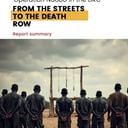
The recent book, 13 Ways of Looking at the Death Penalty, by Mario Marazziti, explores the United States’ continuing use of the death penalty in a world community that is increasingly rejecting the practice. The Philadelphia Inquirer calls the book “an interesting, compelling look at the cultural and religious underpinnings of the death penalty and how we got here. More important, [Marazziti’s] interviews with U.S. death-row inmates — living and now-deceased — their survivors, and their victims’ families highlight the gray of a subject too many paint in black and white.”
Marazziti, who was deeply involved in the efforts that led the United Nations to call for a global moratorium on capital punishment, draws on his experiences as a co-founder of the World Coalition Against the Death Penalty and as spokesperson for the Community of Sant’Egidio, a progressive Catholic organization based in Rome. Pope Francis’ appeal last month for Catholic government officials to work to halt all executions during the Church’s Holy Year of Mercy came on the eve of an international conference against the death penalty organized by the Sant’Egidio Community.
Marazziti’s book includes research, personal narratives of those directly affected by the death penalty, and Marazziti’s own reflections on the issue. Archbishop Desmond Tutu said, “13 Ways of Looking at the Death Penalty by Mario Marazziti is a deeply moving and cogently argued account of why an abominable practice should be abolished. The death penalty dehumanizes those who use it. Its mistakes cannot be corrected.”
Mario Marazziti, 13 Ways of Looking at the Death Penalty, Seven Stories Press, 2015; Joe Slobodzian, New ways of looking at the death penalty, Philadelphia Inquirer, July 13, 2015.


